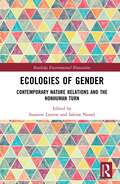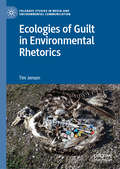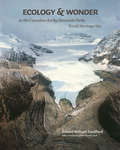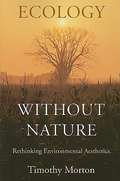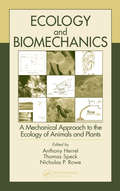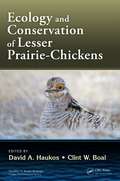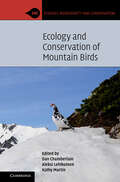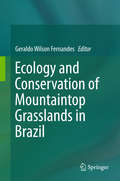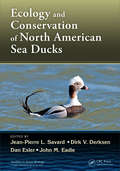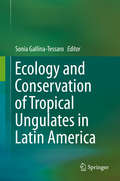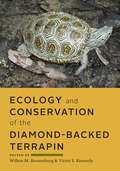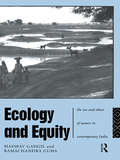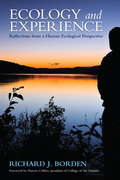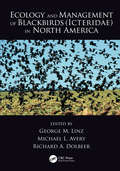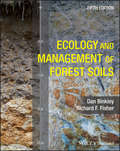- Table View
- List View
Ecologies of Gender: Contemporary Nature Relations and the Nonhuman Turn (Routledge Environmental Humanities)
by Susanne LettowEcologies of Gender: Contemporary Nature Relations and the Nonhuman Turn examines the role of gender in recent debates about the nonhuman turn in the humanities, and critically explores the implications for a contemporary theory of gender and nature relations. The interdisciplinary contributions in this volume each provides theoretical reflections based on an analysis of specific naturecultural processes. They reveal how "ecologies of gender" are constructed through aesthetic, epistemological, political, technological and economic practices that shape multispecies and material interrelations as well as spatial and temporal orderings. The volume includes contributions from cultural anthropology, cultural studies, film studies, literary studies, media studies, philosophy and theatre studies. The essays are organized around four key dimensions of an "ecological" understanding of gender: "creatures", "materials", "spaces" and "temporalities". The overall aim of the volume Ecologies of Gender: Contemporary Nature Relations and the Nonhuman Turn is to explore the potentialities and limitations of the nonhuman turn for a critical analysis and theory of ecologies of gender, and thereby make an original contribution to both the environmental humanities and gender studies. This book will be of great interest to scholars and students from the interdisciplinary field of the environmental humanities and environmental studies more broadly, as well as from gender studies and cultural theory.
Ecologies of Guilt in Environmental Rhetorics (Palgrave Studies in Media and Environmental Communication)
by Tim JensenEnvironmental rhetorics have expanded awareness of mass extinction, climate change, and pervasive pollution, yet failed to generate collective action that adequately addresses such pressing matters. This book contends that the anemic response to ecological upheaval is due, in part, to an inability to navigate novel forms of environmental guilt. Combining affect theory with rhetorical analysis to examine a range of texts and media, Ecologies of Guilt in Environmental Rhetorics positions guilt as a keystone emotion for contemporary environmental communication, and explores how it is provoked, perpetuated, and framed through everyday discourse. In revealing the need for emotional literacies that productively engage our complicity in global ecological harm, the book looks to a future where guilt—and its symbiotic relationships with anger, shame, and grief—is shaped in tune with the ecologies that sustain us.
Ecologizing Education: Nature-Centered Teaching for Cultural Change
by Sean Blenkinsop Estella C. KuchtaEcologizing Education explores how we can reenvision education to meet the demands of an unjust and rapidly changing world. Going beyond "green" schooling programs that aim only to shape behavior, Sean Blenkinsop and Estella Kuchta advance a pedagogical approach that seeks to instills eco-conscious and socially just change at the cultural level. Ecologizing education, as this approach is called, involves identifying and working to overcome anti-ecological features of contemporary education. This approach, called ecologizing education, aims to develop a classroom culture in sync with the more-than-human world where diversity and interdependency are intrinsic.Blenkinsop and Kuchta illustrate this educational paradigm shift through the real-world stories of two public elementary schools located in British Columbia. They show that this approach to learning starts with recognizing the environmental and social injustices that pervade our industrialized societies. By documenting how ecologizing education helps children create new relationships with the natural world and move toward mutual healing, Blenkinsop and Kuchta offer a roadmap for what may be the most potent chance we have at meaningful change in the face of myriad climate crises. Timely, practical, and ultimately inspirational, Ecologizing Education is vital reading for any parent, caregiver, environmentalist, or educator looking for wholistic education that places nature and the environment front and center.
Ecology Without Nature: Rethinking Environmental Aesthetics
by Timothy MortonIn Ecology without Nature, Timothy Morton argues that the chief stumbling block to environmental thinking is the image of nature itself. Ecological writers propose a new worldview, but their very zeal to preserve the natural world leads them away from the "nature" they revere. The problem is a symptom of the ecological catastrophe in which we are living. Morton sets out a seeming paradox: to have a properly ecological view, we must relinquish the idea of nature once and for all. Ecology without Nature investigates our ecological assumptions in a way that is provocative and deeply engaging. Ranging widely in eighteenth-century through contemporary philosophy, culture, and history, he explores the value of art in imagining environmental projects for the future. Morton develops a fresh vocabulary for reading "environmentality" in artistic form as well as content, and traces the contexts of ecological constructs through the history of capitalism. From John Clare to John Cage, from Kierkegaard to Kristeva, from The Lord of the Rings to electronic life forms, Ecology without Nature widens our view of ecological criticism, and deepens our understanding of ecology itself. Instead of trying to use an idea of nature to heal what society has damaged, Morton sets out a radical new form of ecological criticism: "dark ecology. "
Ecology and Biomechanics: A Mechanical Approach to the Ecology of Animals and Plants
by Anthony Herrel Thomas Speck Nicholas P. RowedWe live in a well-engineered universe. This engineering is present in every system and organism in existence, including in the actions and interactions of plants and animals. In fact, one could say that the function and movement of plants and animals is just as much a part of their makeup as chlorophyll and fiber or bone and blood. Consequently, if
Ecology and Conservation of Birds in Urban Environments
by Enrique Murgui Marcus HedblomThis book provides syntheses of ecological theories and overarching patterns of urban bird ecology that have only recently become available. The numerous habitats represented in this book ranges from rows of trees in wooded alleys, to wastelands and remnants of natural habitats encapsulated in the urban matrix. Authored by leading scientists in this emergent field, the chapters explore how the characteristics of the habitat in urban environments influence bird communities and populations at multiple levels of ecological organization and at different spatial and temporal scales, and how this information should be incorporated in urban planning to achieve an effective conservation of bird fauna in urban environments. Birds are among the most conspicuous and fascinating residents of urban neighborhoods and provide urban citizens with everyday wildlife contact all over the world. However, present urbanization trends are rapidly depleting their habitats, and thus knowledge of urban bird ecology is urgently needed if birds are to thrive in cities. The book is unique in its inclusion of examples from all continents (except Antarctica) in an effort to arrive at a more holistic perspective. Among other issues, the individual chapters address the censusing of birds in urban green spaces; the relationship between bird communities and the structure of urban green spaces; the role of exotic plant species as food sources for urban bird fauna; the influence of artificial light and pollutants on bird fauna; trends in long-term urban bird research, and transdisciplinary studies on bird sounds and their effects on humans. Several chapters investigate how our current knowledge of the ecology of urban bird fauna should be applied in order to achieve better management of urban habitats so as to achieve conservation of species or even increase species diversity. The book also provides a forward-looking summary on potential research directions. As such, it provides a valuable resource for urban ecologists, urban ecology students, landscape architects, city planners, decision makers and anyone with an interest in urban ornithology and bird conservation. Moreover, it provides a comprehensive overview for researchers in the fields of ecology and conservation of urban bird fauna.
Ecology and Conservation of Fishes
by Harold M. TyusWritten as a stand-alone textbook for students and a useful reference for professionals in government and private agencies, academic institutions, and consultants, Ecology and Conservation of Fishes provides broad, comprehensive, and systematic coverage of all aquatic systems from the mountains to the oceans. The book begins with overview discussio
Ecology and Conservation of Lesser Prairie-Chickens (Studies in Avian Biology)
by Clint W. Boal David A. HaukosShortlisted for the 2018 TWS Wildlife Publication Awards in the edited book categoryLesser Prairie-Chickens have experienced substantial declines in terms of population and the extent of area that they occupy. While they are an elusive species, making it difficult at times to monitor them, current evidence indicates that they have been persistently
Ecology and Conservation of Mountain Birds (Ecology, Biodiversity and Conservation)
by Kathy Martin Dan Chamberlain Aleksi LehikoinenHigh mountain habitats are globally important for biodiversity. At least 12% of birds worldwide breed at or above the treeline, many of which are endemic species or species of conservation concern. However, due to the challenges of studying mountain birds in difficult-to-access habitats, little is known about their status and trends. This book provides the first global review of the ecology, evolution, life history and conservation of high mountain birds, including comprehensive coverage of their key habitats across global mountain regions, assessments of diversity patterns along elevation gradients, and adaptations for life in the alpine zone. The main threats to mountain bird populations are also identified, including climate change, human land use and recreational activities. Written for ecologists and naturalists, this book identifies key knowledge gaps and clearly establishes the research priorities needed to increase our understanding of the ecology of mountain birds and to aid in their conservation.
Ecology and Conservation of Mountaintop grasslands in Brazil
by Geraldo Wilson FernandesThis book is a pioneer attempt to bring forward the first synthesis on the most diverse and threatened mountain top vegetation of South America, the rupestrian grasslands. It brings to light the state of the art information on this ecosystem geology, soil formation and distribution, environmental filters that lead to biodiversity, species interactions and their fine tuned adaptations to survive the harsh mountain environment. The human dimensions of the rupestrian grassland are also addressed, including the anthropogenic threats that may irreversibly impact biodiversity and ecosystem services. The book also highlights the ongoing studies on ecological restoration and first attempt to model the impacts of climate change on its speciose biota.
Ecology and Conservation of North American Sea Ducks (Studies in Avian Biology)
by Dirk V. Derksen Dan Esler John M. Eadie Jean-Pierre L. SavardThe past decade has seen a huge increase in the interest and attention directed toward sea ducks, the Mergini tribe. This has been inspired, in large part, by the conservation concerns associated with numerical declines in several sea duck species and populations, as well as a growing appreciation for their interesting ecological attributes. Reflec
Ecology and Conservation of Pinnipeds in Latin America
by Gisela Heckel Yolanda SchrammPinnipeds are marine mammals that include eared seals, true seals, and walruses. This book presents detailed reviews on the ecology and conservation of 10 pinniped species along the coasts and islands in Latin America, from Mexico to Chile and Argentina. Topics covered include their population dynamics, trophic ecology, reproduction, and behavior. In addition, the book addresses major conservation issues regarding climate change, interaction with fisheries, ecotourism, and other human activities.
Ecology and Conservation of Tropical Ungulates in Latin America
by Sonia Gallina-TessaroThis book brings together the latest information on tropical ungulates in different Latin American countries. These animals are not only important from the point of view of their role in different ecosystems, but also have cultural value for people. The book also discusses topics such as habitat transformation and hunting as these species are an important source of food in many places. Addressing ungulate natural communities in diverse ecosystems and countries, the book provides information on specific aspects of each of the most representative species, and highlights topics to help readers better understand these species and develop effective management and conservation strategies. The information presented also reveals the need for more knowledge and will hopefully provide the incentive for continued studies on this important group of animals. This publication serves as a reference for academic research on ungulate ecology, behavior and dynamics, as well as the basis for conservation strategies.
Ecology and Conservation of the Diamond-backed Terrapin
by Willem M. Roosenburg and Victor S. KennedyA fascinating look at the diamond-backed terrapin—an important, iconic, and imperiled American reptile.The diamond-backed terrapin is not only a uniquely evolved and beautiful turtle, it also has a long history as a vital American food source. Once so numerous that people reportedly grew tired of eating them, diamond-backed terrapins are greatly reduced in numbers today and have become an icon of salt marsh conservation. Considerably diminished in some areas and struggling to survive, this distinctive brackish water turtle is the focus of intense conservation efforts. In Ecology and Conservation of the Diamond-backed Terrapin, leading terrapin researcher Willem M. Roosenburg and experienced science editor Victor S. Kennedy have brought together a group of expert scientists to summarize our current understanding of terrapin biology, physiology, behavior, and conservation efforts. Over the course of 19 comprehensive chapters, contributors • review the latest information on this charismatic species • provide a detailed summary of the terrapin's natural history • explain the threats to terrapin population stability throughout their range• examine ongoing conservation efforts to ensure the reptile's survival• present convincing arguments for the value of the diamond-backed terrapin as an estuarine indicator organism• use the terrapin as a model for studying the consequences of exploitation and environmental degradation on long-lived speciesThis exceptional book provides pivotal information for estuarine and turtle biologists, terrapin enthusiasts, natural historians, educators, conservationists, resource managers, and students. Ecology and Conservation of the Diamond-backed Terrapin is the definitive volume on this important American reptile.Contributors: Benjamin K. Atkinson, Harold W. Avery, Patrick J. Baker, Ralph E.J. Boerner, Russell L. Burke, Joseph A. Butler, Randolph M. Chambers, Paul E. Converse, Brian A. Crawford, Rusty D. Day, Dana J. Ehret, J. Whitfield Gibbons, Kathryn M. Greene, Leigh Anne Harden, Andrew S. Harrison, Kristen M. Hart, George L. Heinrich, Dawn K. Holliday, Victor S. Kennedy, Shawn R. Kuchta, Lori A. Lester, Jeffrey E. Lovich, John C. Maerz, David Owens, Allen R. Place, Taylor Roberge, Willem M. Roosenburg, Richard A. Seigel, Amanda Southwood Williard, Edward A. Standora, Anton D. Tucker, Diane C. Tulipani, Timothy J. Walsh, Thane Wibbels, Will Williams, Roger C. Wood
Ecology and Conservation of the Maned Wolf: Multidisciplinary Perspectives
by Adriana G. Consorte-McCrea Eliana Ferraz SantosWolves are controversial figures worldwide and much effort has focused on how to conserve them while addressing public concerns. With its solitary habits and fruit-eating diet, the endangered maned wolf roams the South American grasslands and swamps, playing a vital part in maintaining biodiversity hotspots. In recent years, much effort has focused on the discussion of how to conserve large carnivores, such as wolves, while addressing public concerns. Gathering the work of leading researchers from diverse areas and countries, this book covers up-to-date research on the biology, ecology, and conservation of the maned wolf. It presents innovative insights that can benefit conservation strategies (in and ex situ health, feeding ecology, distribution, and people's attitudes) and offers diverse perspectives for the future of the species (education, human dimensions, ethnoconservation, and habitat studies).
Ecology and Design: Frameworks For Learning
by Kristina Hill Robert Melnick Bart JohnsonProfessionals, faculty, and students are aware of the pressing need to integrate ecological principles into environmental design and planning education, but few materials exist to facilitate that development.Ecology and Design addresses that shortcoming by articulating priorities and approaches for incorporating ecological principles in the teaching of landscape design and planning. The book explains why landscape architecture and design and planning faculty should include ecology as a standard part of their courses and curricula, provides insights on how that can be done, and offers models from successful programs. The book: examines the need for change in the education and practice of landscape architecture and in the physical planning and design professions as a whole asks what designers and physical planners need to know about ecology and what applied ecologists can learn from design and planning develops conceptual frameworks needed to realize an ecologically based approach to design and planning offers recommendations for the integration of ecology within a landscape architecture curriculum, as an example for other design fields such as civil engineering and architecture considers the implications for professional practice explores innovative approaches to collaboration among designers and ecologistsIn addition to the editors, contributors include Carolyn Adams, Jack Ahern, Richard T. T. Forman, Michael Hough, James Karr, Joan Iverson Nassauer, David Orr, Kathy Poole, H. Ronald Pulliam, Anne Whiston Spirn, Sandra Steingraber, Carl Steinitz, Ken Tamminga, and William Wenk. Ecology and Design represents an important guidepost and source of ideas for faculty, students, and professionals in landscape architecture, urban design, planning and architecture, landscape ecology, conservation biology and restoration ecology, civil and environmental engineering, and related fields.
Ecology and Development in the Third World (Routledge Introductions To Development Ser.)
by Avijit Gupta A. GuptaThis comprehensive second edition provides an up-to-date introduction to the nature of ecological degradation in a world of dramatic environmental change.
Ecology and Environment
by R N Bhargava V Rajaram Keith Olson Lynn TiedeThe alarming rise in greenhouse gas and pollution level which has resulted in serious environmental and ecological harm is the biggest concern today. It has not only made the lives of mankind miserable but also threatens their very existence. Ecology and Environment has delved in depth on the subject and brings a broad perspective of the various issues. Following the curriculum of University Grants Commission, the book covers different types of ecosystem on the earth. It deals with the effective and sustainable use of natural resources which includes water, forest, mineral resources in the ground and productive land. The book explains the population trends in the world and India, and how it is impacting the environment. The role of public participation in promoting environmental sustainability is explored too. Please note: This volume is Co-published with The Energy and Resources Institute Press, New Delhi. Taylor & Francis does not sell or distribute the Hardback in India, Pakistan, Nepal, Bhutan, Bangladesh and Sri Lanka
Ecology and Equity: The Use and Abuse of Nature in Contemporary India (Oxford India Paperbacks Ser.)
by Ramachandra Guha Madhav GadgilEnvironmental destruction is seen a matter of worldwide concern but as a Third World problem. Ecology and Equity explores the most ecologically complex country in the world. India's peoples range from technocrats to hunter-gathers and its environments from dense forest to wasteland. The bookanalyses the use and abuse of nature on the sub-continent to reveal the interconnections of social and environmental conflict on the global scale. The authors argue that the root of this conflict is competition within different social groups and between different economic interests for natural resources. Radical both in its critique of the causes of crisis in India and in its proposals for ecological reform, Ecology and Equity is essential reading for all concerned for the Third World's in the world.
Ecology and Evolution of Rhizobia: Principles and Applications
by En Tao Wang Wen Feng Chen Chang Fu Tian Wen Xin Chen J. Peter YoungThis book reviews the history and development of rhizobial ecology (diversity, function and interactions with the biotic and abiotic environments), evolution (genome diversification, systematics of symbiotic genes) and application. Further, it describes the new concept of rhizobia, the latest systematic methods, biogeographic study methods, and genomic studies to identify the interactions between rhizobia, legumes and environments. To enable readers to gain a comprehensive understanding of rhizobial biogeography, the book provides effective protocols for the selection and application of high-efficiency rhizobial inoculants. In addition, it presents standard and modern methods used in studies on rhizobial ecology and evolution in dedicated appendices, making it a unique and valuable handbook for researchers.
Ecology and Experience
by Richard J. Borden Darron CollinsA philosophical and narrative memoir, Ecology and Experience is a thoughtful, engaging recounting of author Richard J. Borden's life entwined in an overview of the intellectual and institutional history of human ecology--a story of life wrapped in a life story. Borden shows that attempts to bridge the mental and environmental arenas are uncertain, but that rigid conventions and narrow views have their dangers too. Human experience and the natural world exist on many levels and gathering from both realms gives rise to novel constellations. In a blend of themes and approaches based on a lifetime of interdisciplinary inquiry, the author wanders these intersections and invites us to exercise our capacities for ecological insight, to deepen the experience of being alive, and, most of all, to more fully enrich our lives.ContentsForeword by Darron Collins, president of the College of the AtlanticPrefacePart I. Transects and Plots1. The Arc of Life2. Ecology3. Experience4. Human Ecology5. EducationPart II. Facets of Life6. Time and Space7. Death in Life8. Personal Ecology9. Context10. Metaphor and MeaningPart III. Wider Points of View11. Kinds of Minds12. Insight13. Imagination14. Keyholes15. Ecology and Identity16. The Unfinished CoursePart IV. CodaFrom the Trade Paperback edition.
Ecology and Management of Black-tailed and Mule Deer of North America
by James R. Heffelfinger and Paul R. KrausmanBlack-tailed and mule deer represent one of the largest distributions of mammals in North America and are symbols of the wide-open American West. Each chapter in this book was authored by the world’s leading experts on that topic. Both editors, James R. Heffelfinger and Paul R. Krausman, are widely published in the popular and scientific press and recipients of the O. C. Wallmo Award, given every two years to a leading black-tailed and mule deer expert who has made significant contributions to the conservation of this species. In addition, Heffelfinger has chaired the Mule Deer Working Group sponsored by the Western Association of Fish and Wildlife Agencies for more than 15 years. This working group consists of the leading black-tailed and mule deer experts from each of 24 states, provinces, and territories in western North America, putting them at the forefront of all conservation and much of the research on this species. The book represents all current knowledge available on these deer, including how changing conditions such as fires, habitat alteration and loss, disease, climate change, socio-economic forces, energy development, and other aspects are influencing their distribution and abundance now and into the future. It takes a completely fresh look at all chapter topics. The revisions of distribution, taxonomy, evolution, behavior, and new and exciting work being done in deer nutrition, migration and movements, diseases, predation, and human dimensions are all assembled in this volume. This book will instantly become the foundation for the latest information and management strategies to be implemented on the ground by practitioners and to inform the public. Although this book is about deer, the topics discussed influence most terrestrial wildlife worldwide, and the basic concepts in many of the chapters are applicable to other species.
Ecology and Management of Blackbirds (Icteridae) in North America
by George M. Linz Michael L. Avery Richard A. DolbeerShortlisted for the 2018 TWS Wildlife Publication Awards in the edited book category The various species of new world blackbirds, often intermingled in large foraging flocks and nighttime roosts, collectively number in the hundreds of millions and are a dominant component of the natural and agricultural avifauna in North America today. Because of their abundance, conspicuous flocking behavior, and feeding habits, these species have often been in conflict with human endeavors. The pioneering publications on blackbirds were by F. E. L. Beal in 1900 and A. A. Allen in 1914. These seminal treatises laid the foundation for more than 1,000 descriptive and experimental studies on the life histories of blackbirds as well as their ecology and management in relation to agricultural damage and other conflicts such as caused by large winter roosting congregations. The wealth of information generated in over a century of research is found in disparate outlets that include government reports, conference proceedings, peer-reviewed journals, monographs, and books. For the first time, Ecology and Management of Blackbirds (Icteridae) in North America summarizes and synthesizes this vast body of information on the biology and life histories of blackbirds and their conflicts with humans into a single volume for researchers, wildlife managers, agriculturists, disease biologists, ornithologists, policy makers, and the public. The book reviews the life histories of red-winged blackbirds, yellow-headed blackbirds, common grackles, and brown-headed cowbirds. It provides in-depth coverage of the functional roles of blackbirds in natural and agricultural ecosystems. In doing so, this authoritative reference promotes the development of improved science-based, integrated management strategies to address conflicts when resolutions are needed.
Ecology and Management of Forest Soils
by Dan Binkley Richard F. FisherContemporary soil science and conservation methods of effective forestry Forests and the soils that serve as their foundation cover almost a third of the world’s land area. Soils influenced by forest cover have different properties than soils cultivated for agricultural use. Ecology and Management of Forest Soils provides a clear and comprehensive overview of the composition, structure, processes, and management of the largest terrestrial ecosystem. From composition and biogeochemistry to dynamics and management, this essential text enables readers to understand the vital components of sustainable, long-term forest soil fertility. The interaction of trees, animals, microbes, and vegetation alter the biology and chemistry of forest soils—these dynamics are also subject to human management, requiring conservationists to be conversant in the philosophy and methods of soil science. Now in its fifth edition, this classic text includes new coverage of uptake of organic nitrogen in forests, 15N retention studies, the effects of N additions on C accumulation, evidence-based examples of the dynamics of soils, and more. Extensive updates and revisions to topics such as spatial implications of megafires, long‐term organic matter accumulation, soil characterization, and molecular soil measurement techniques reflect contemporary research and practices in the field. This informative overview of forest soils integrates clear and accurate descriptions of central concepts and logically organized chapters to provide readers with foundational knowledge of major soil features, processes, measurement techniques, and management methods. This authoritative survey of the management and ecology of forest soils: Offers full-color photographs and illustrations, real-world examples and case studies, and clear overviews to each topic Presents up-to-date and accessible coverage of contemporary forest science literature and research Addresses topical issues relevant to areas such as ecology, forest management, conservation, and government policy Provides a comprehensive, global perspective on forest soils, from tropical to temperate to boreal Presents balanced coverage of soil science principles and their practical application to forest management Ecology and Management of Forest Soils offers students in areas of soil science and forestry, natural resource and environmental management, ecology, agronomy, and conservation an invaluable overview of the field, while providing forestry professionals an efficient and current work of reference.
